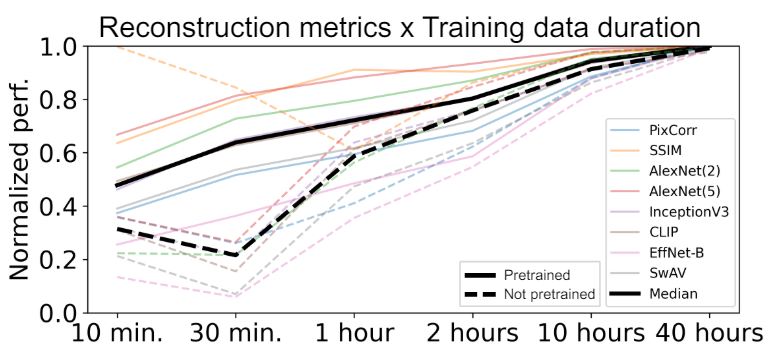Table of Links
2 MindEye2 and 2.1 Shared-Subject Functional Alignment
2.2 Backbone, Diffusion Prior, & Submodules
2.3 Image Captioning and 2.4 Fine-tuning Stable Diffusion XL for unCLIP
3 Results and 3.1 fMRI-to-Image Reconstruction
3.3 Image/Brain Retrieval and 3.4 Brain Correlation
6 Acknowledgements and References
A Appendix
A.2 Additional Dataset Information
A.3 MindEye2 (not pretrained) vs. MindEye1
A.4 Reconstruction Evaluations Across Varying Amounts of Training Data
A.5 Single-Subject Evaluations
A.7 OpenCLIP BigG to CLIP L Conversion
A.9 Reconstruction Evaluations: Additional Information
A.10 Pretraining with Less Subjects
A.11 UMAP Dimensionality Reduction
A.13 Human Preference Experiments
3.2 Image Captioning
Predicted image captions are quantitatively compared to previous work in Table 2. UniBrain (Mai and Zhang, 2023) was first to predict captions using NSD, training a diffusion model to predict CLIP ViT-L/14 text latents which get fed through a pretrained Optimus GPT2 model (Radford et al., 2019). Ferrante et al. (2023b) predicted image captions by mapping fMRI inputs to CLIP ViT-L/14 image latents via ridge regression, passing these latents through a pretrained GIT model (Wang et al., 2022).
We adopt the same caption metrics reported in the previous work. ROUGE (Lin, 2004) and METEOR (Banerjee and Lavie, 2005) capture aspects of text structure and composition. CLIP (Radford et al., 2021) and Sentence

Transformer ("all-MiniLM-L6-v2") (Reimers and Gurevych, 2020) are higher-level metrics that provide insight into textual context, relationships, and semantics. All metrics except ROUGE were calculated using the same code as Ferrante et al. (2023b). MindEye2 captioning performance outperformed previous models across all metrics except one, suggesting high-quality image captions from brain activity.

This paper is available on arxiv under CC BY 4.0 DEED license.
Authors:
(1) Paul S. Scotti, Stability AI and Medical AI Research Center (MedARC);
(2) Mihir Tripathy, Medical AI Research Center (MedARC) and a Core contribution;
(3) Cesar Kadir Torrico Villanueva, Medical AI Research Center (MedARC) and a Core contribution;
(4) Reese Kneeland, University of Minnesota and a Core contribution;
(5) Tong Chen, The University of Sydney and Medical AI Research Center (MedARC);
(6) Ashutosh Narang, Medical AI Research Center (MedARC);
(7) Charan Santhirasegaran, Medical AI Research Center (MedARC);
(8) Jonathan Xu, University of Waterloo and Medical AI Research Center (MedARC);
(9) Thomas Naselaris, University of Minnesota;
(10) Kenneth A. Norman, Princeton Neuroscience Institute;
(11) Tanishq Mathew Abraham, Stability AI and Medical AI Research Center (MedARC).
